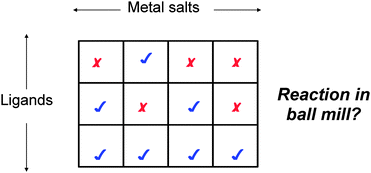An array-based approach is put forward to obtain insight into reactivity under mechanochemical solvent-free conditions. We describe a survey of sixty potential reactions between twelve metal salts MX2 {(M = Cu, X2 = (OAc)2, (HCO2)2, (F3CCO2)2, (acac)2, (F6acac)2, (NO3)2, SO4; M = Ni, X2 = (OAc)2, (NO3)2, SO4; M = Zn, X2 = (OAc)2, (NO3)2} and five bridging organic ligands {isonicotinic acid (HINA), 1,4-benzenedicarboxylic acid (H2BDC), acetylenedicarboxylic acid (H2ADC), 1,3,5-benzenetricarboxylic acid (H3BTC), 4,4′-bipyridyl (BIPY). Reaction conditions involved a ball mill, applied for 15 min at 30 Hz, without external heating. When examined by XRPD, forty of the combinations gave detectable reactions, thirty-eight with crystalline products. Of these, twenty-nine reactions were quantitative (consuming all of at least one reactant). Comparison of XRPD patterns with patterns simulated from single crystal X-ray diffraction data in the Cambridge Structural Database allowed structural identification of six products. Of particular interest are the microporous framework materials [Cu(INA)2] and [Cu3(BTC)2] (HKUST-1) obtained by reaction of the corresponding carboxylic acids with copper acetate. Other non-porous polymers with 3-dimensional connectivity, [Ni(ADC)(H2O)4], or 1-dimensional connectivity, [Cu(acac)2(BIPY)] and [Cu(F6acac)(BIPY)] were also obtained. Reaction between zinc acetate and H2ADC gave a new product which had not previously been characterised by single-crystal X-ray crystallography, but whose XRPD pattern suggests that it is isostructural with the known nickel polymer [Ni(ADC)(H2O)4]. Two further isostructural nickel and zinc products were obtained in reactions between HINA and nickel nitrate and zinc nitrate. Trends observed within the array are discussed. Copper acetate and copper formate were the most effective starting materials for reaction with carboxylic acids, potentially related to the basicity of their anions and the solvating effects of the formic and acetic acid byproducts. Amongst the ligands there was a general negative corelation between melting point and reactivity. The issue of pore templating in microporous phases and the generation of new structures is also discussed in relation to the Cu(INA)2, Cu3(BTC)2 and nickel nitrate-BIPY systems. Overall, the study suggests that mechanochemical reactivity between metal salts and organic ligands under solvent free conditions is remarkably general. Use of array-based approaches as demonstrated here is advocated a useful way to reveal underlying trends in reactivity under solvent free mechanochemical conditions and to highlight particular cases for more detailed study.


 Please wait while we load your content...
Please wait while we load your content...